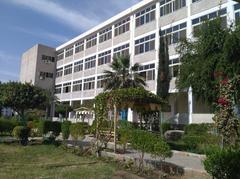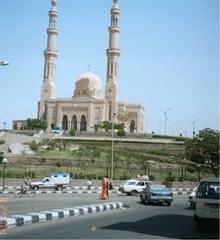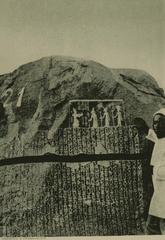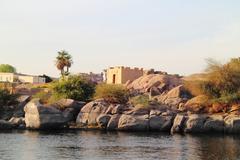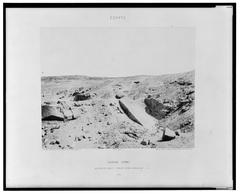Visiting the Aswan Museum, Aswan, Egypt: Complete Guide including Tickets, Hours, and Nearby Attractions
Date: 14/06/2025
Introduction to the Aswan Museum and Its Significance
Situated on Elephantine Island in Aswan, Egypt, the Aswan Museum serves as a vital gateway to understanding the region’s deep and diverse heritage. Established in 1912 by British Egyptologist Cecil Mallaby Firth, the museum was initially designed to preserve artifacts uncovered on the island—one of Egypt’s oldest continually inhabited sites, dating back to the Early Dynastic Period. Over the years, its collections have expanded to encompass Nubian, Pharaonic, Greco-Roman, Coptic, and Islamic artifacts, illustrating thousands of years of cultural evolution.
The museum’s unique layout integrates indoor galleries with outdoor ruins, allowing visitors to experience ancient temples, shrines, and settlements in their archaeological context. Highlights include statues of deities such as Khnum, mummies, Nilometers, and rescued Nubian artifacts, as well as exhibits documenting the resilience and traditions of Nubian communities—particularly in the face of displacement following the construction of the Aswan High Dam.
Easily accessible by a short boat ride from central Aswan, the Aswan Museum is a cornerstone for archaeological research and a hub for sustainable tourism in southern Egypt. This complete guide offers comprehensive details on the museum’s history, collections, visitor information, ticketing, accessibility, and nearby attractions, ensuring that your experience is both enriching and well-planned (Wikipedia; Youregypttours; travel2egypt.org; Discoveny).
Table of Contents
- Origins and Establishment of the Aswan Museum
- Evolution and Expansion
- Architectural and Curatorial Approach
- Key Collections and Artifacts
- Historical Significance of Elephantine Island
- Visiting the Aswan Museum: Hours, Tickets, and Travel Tips
- Visitor Experience and Facilities
- Practical Tips for Visitors
- Nearby Attractions
- Frequently Asked Questions (FAQ)
- Conclusion and Call to Action
- Sources and Further Reading
Origins and Establishment of the Aswan Museum
The Aswan Museum was founded in 1912 by Cecil Mallaby Firth to house and safeguard artifacts from Elephantine Island, a site of immense historical and archaeological value. The island, located at Egypt’s southern frontier, had long served as a military post, religious center, and vital trade hub. Its strategic location and layered past made it a focal point for early 20th-century archaeological efforts (Wikipedia; Nile Holiday; Agate Travel).
Evolution and Expansion
Originally, the museum’s collection centered on artifacts discovered on Elephantine Island, such as pottery, tools, and statues reflecting daily life and religious traditions. With the construction of the Aswan Dam, the museum’s role expanded, becoming a repository for Nubian and Pharaonic artifacts rescued from sites threatened by flooding. In 1990, a major extension was added, featuring new finds from ongoing excavations, such as utensils, weapons, pottery, and mummies, further enriching the narrative of life along the Nile (Wikipedia).
Architectural and Curatorial Approach
The museum is housed in the historic villa of Sir William Willcocks, the engineer behind the first Aswan Dam, and is surrounded by lush gardens. Its modest, harmonious design blends colonial and Nubian architectural elements, and its layout uniquely fuses indoor galleries with open-air ruins. Visitors engage directly with archaeological remains—standing amidst ancient temples, Nilometers, and settlements—while curated displays provide historical context (Nile Holiday; Egipto Exclusivo).
Key Collections and Artifacts
The Aswan Museum’s collection spans over 5,000 years, representing the major eras of Egyptian and Nubian history. Noteworthy highlights include:
- Pharaonic Statues and Stelae: Statues of Khnum (the ram-headed god of the Nile), Satet, and other deities, as well as stelae and sarcophagi with detailed hieroglyphic inscriptions (Hurghada Lovers).
- Nubian Antiquities: Pottery, jewelry, and funerary items that illustrate the Nubian-Egyptian cultural exchange.
- Mummies and Coffins: Human and animal mummies, intricately decorated coffins, and items related to ancient funerary practices.
- Daily Life Artifacts: Utensils, tools, and personal items spanning the Old Kingdom to the Islamic era (Wikipedia).
- Greco-Roman and Coptic Relics: Coins, ceramics, crosses, textiles, and statues highlighting the region’s cosmopolitan history.
- Islamic Era Objects: Pottery, lamps, and jewelry from Aswan’s Islamic period (egypttoursportal.com).
Historical Significance of Elephantine Island
Elephantine Island has served as a border post, religious center, and commercial gateway linking Egypt to Nubia and sub-Saharan Africa. The island was home to temples dedicated to Khnum and other deities, and it features some of Egypt’s best-preserved Nilometers—ancient devices for measuring the Nile’s flood levels. The island’s ruins, combined with the museum’s exhibits, illuminate the development of frontier society, religious beliefs, and administrative practices over millennia (Agate Travel; Nile Holiday).
Visiting the Aswan Museum: Hours, Tickets, and Travel Tips
- Opening Hours: The Aswan Museum is open daily from 9:00 AM to 5:00 PM. During public holidays or Ramadan, hours may vary—verify locally or online (Discoveny).
- Tickets and Admission: As of June 2025, tickets cost 200 EGP for adults and 100 EGP for students/children. Payment is accepted in Egyptian pounds, and most ticket offices also accept credit cards (Discoveny; Far and Beyond Travel; official portal).
- How to Get There: The museum is on Elephantine Island, accessible by a 10-minute public ferry or private boat from Aswan’s Corniche. The ferry ride offers scenic views of the Nile (Discoveny; Egypt For Travel).
- Accessibility: The museum building and gardens are partially accessible for those with limited mobility, though the archaeological sites have uneven terrain. All exhibit labels are bilingual (Arabic and English).
Visitor Experience and Facilities
- Gardens and Setting: The museum is surrounded by tranquil gardens, offering panoramic Nile views and shaded benches for rest (Egipto Exclusivo).
- Restrooms and Amenities: Basic facilities are available.
- Photography: Non-flash photography is generally permitted; confirm current policies upon entry.
- Guided Tours: Onsite guards may provide brief explanations, but for an in-depth experience, consider hiring a licensed guide in advance.
- Special Events: The museum occasionally hosts temporary exhibitions and participates in cultural festivals such as the Nubian Festival and Abu Simbel Sun Festival (EgyptaTours).
Practical Tips for Visitors
- Best Time to Visit: October to April offers the most comfortable weather. Early mornings or late afternoons are ideal for avoiding heat and crowds.
- What to Bring: Sun protection (sunscreen, hat), bottled water, comfortable shoes, and small cash for purchases or tips.
- Safety and Etiquette: The site is safe, with visible security. Dress modestly and respect conservation rules by avoiding touching artifacts and refraining from littering.
Nearby Attractions
- Nubian Museum: Showcases the art, history, and traditions of Nubian culture, a short ferry ride away (PlanetWare).
- Aswan Botanical Garden: Located on Kitchener’s Island, accessible by boat.
- Philae Temple: A major ancient site dedicated to the goddess Isis, reachable by taxi and boat.
- Unfinished Obelisk: Ancient quarry demonstrating stone-working techniques.
- Aswan High Dam: An engineering marvel and important symbol of Egypt’s modern history.
Frequently Asked Questions (FAQ)
Q: What are the Aswan Museum’s opening hours?
A: Daily, 9:00 AM to 5:00 PM (hours may vary on holidays).
Q: How much are tickets?
A: 200 EGP for adults, 100 EGP for students/children (as of June 2025).
Q: Can I buy tickets online?
A: Yes, via the official Egyptian Monuments portal or trusted travel agencies.
Q: Is the museum accessible for visitors with disabilities?
A: The main building and gardens are partially accessible; the archaeological areas may be challenging.
Q: Are guided tours available?
A: Not offered formally onsite, but hiring a licensed guide in advance is recommended.
Q: What are the payment methods?
A: Egyptian pounds and credit cards at most ticket offices.
Conclusion and Call to Action
The Aswan Museum stands as a testament to the rich tapestry of Egypt’s southern frontier, seamlessly blending archaeological treasures, Nubian heritage, and serene natural beauty. With its accessible hours, affordable ticketing, and unique setting on Elephantine Island, it provides a multidimensional experience for travelers of all backgrounds. Whether you’re a history enthusiast, culture seeker, or casual visitor, the museum promises an immersive journey through time.
For the latest updates on hours, ticketing, and exhibitions, consult the official Egyptian Monuments portal or the Ministry of Tourism and Antiquities. Download the Audiala app for up-to-date travel tips, digital guides, and exclusive content. Ready for your journey? Plan your visit, explore nearby wonders, and help preserve Egypt’s enduring legacy.
Sources and Further Reading
- Aswan Museum - Wikipedia
- Aswan Museum Elephantine Island - Nile Holiday
- Aswan Museum - Youregypttours
- The Best Time of the Year to Visit Aswan - EgyptaTours
- Aswan Travel Guide - Travel2Egypt
- Elephantine Island Aswan - Discoveny
- Aswan Museum Entrance Ticket Prices - Far and Beyond Travel
- Egypt Monuments Official Portal
- PlanetWare - Aswan Tourist Attractions
- Egipto Exclusivo - Aswan
- Egypt For Travel - Aswan Museum
- Hurghada Lovers - Elephantine Island
- Egypt Tours Portal - Nubian Museum
- Nile Empire - Egypt Attractions and Entrance Fees
- Emo Tours Egypt - Aswan Attractions
